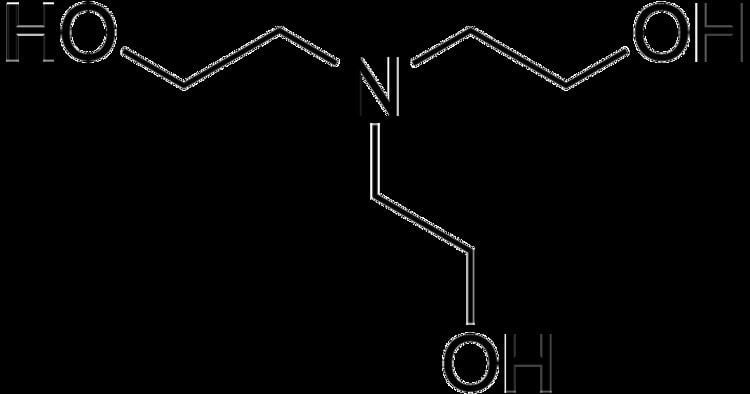3DMet B01049 Related compounds | Appearance Colourless liquid | |
 | ||
Related alkanols | ||
Triethanolamine, often abbreviated as TEA, is a viscous organic compound that is both a tertiary amine and a triol. A triol is a molecule with three alcohol groups. Triethanolamine is a strong base. Triethanolamine can also be abbreviated as TEOA, which can help to distinguish it from triethylamine. Approximately 150,000 tonnes were produced in 1999. It is a colourless compound although samples may appear yellow because of impurities.
Contents
Production
Triethanolamine is produced from the reaction of ethylene oxide with aqueous ammonia, also produced are ethanolamine and diethanolamine. The ratio of the products can be controlled by changing the stoichiometry of the reactants.
Applications
Triethanolamine is used primarily in making surfactants, such as for emulsifier. It is a common ingredient in formulations used for both industrial and consumer products. The triethanolamine neutralizes fatty acids, adjusts and buffers the pH, and solubilizes oils and other ingredients that are not completely soluble in water. Triethanolammonium salts in some cases are more soluble than salts of alkali metals that might be used otherwise, and results in less alkaline products than would from using alkali metal hydroxides to form the salt.. Some common products in which triethanolamine is found are liquid laundry detergents, dishwashing liquids, general cleaners, hand sanitizers, polishes, metalworking fluids, paints, shaving cream and printing inks.
Cement production
Triethanolamine is also used as organic additive (0.1 wt%) in the grinding of cement clinker. It facilitates the grinding process by preventing agglomeration and coating of the powder at the surface of balls and mill wall.
Cosmetics and medicine
Various ear diseases and infections are treated with eardrops containing triethanolamine polypeptide oleate-condensate, such as Cerumenex in the United States. In pharmaceutics, triethanolamine is the active ingredient of some eardrops used to treat impacted earwax. It also serves as a pH balancer in many different cosmetic products, ranging from cleansing creams and milks, skin lotions, eye gels, moisturizers, shampoos, shaving foams, and so on. TEA is a fairly strong base: a 1% solution has a pH of approximately 10, whereas the pH of skin is less than pH 7, approximately 5.5−6.0. Cleansing milk–cream emulsions based on TEA are particularly good at removing makeup. (HOCH2)3N was used in the synthesis of amustaline.
In the laboratory and in amateur photography
Another common use of TEA is as a complexing agent for aluminium ions in aqueous solutions. This reaction is often used to mask such ions before complexometric titrations with another chelating agent such as EDTA. TEA has also been used in photographic (silver halide) processing. It has been promoted as a useful alkali by amateur photographers.
In holography
TEA is used to provide a sensitivity boost to silver-halide-based holograms, and also as a swelling agent to color shift holograms. You can get the sensitivity boost without the color shift by rinsing out the TEA before squeegee and drying.
In electroless plating
TEA is now commonly and very effectively used as a complexing agent in electroless plating.
In ultrasonic testing
2-3% in water TEA is used as an corrosion inhibitor (anti-rust) agent in immersion ultrasonic testing.
Allergic reactions
A 1996 study found that triethanolamine (TEA) occasionally causes contact allergy. A 2001 study found TEA in a sunscreen caused an allergic contact dermatitis. A 2007 study found TEA in ear drops caused a contact allergy. Systemic and respiratory tract (RT) toxicity was analyzed for 28 days in a nose specific inhalation 2008 study in Wistar rats; TEA seems to be less potent in regard to systemic toxicity and RT irritancy than diethanolamine (DEA). Exposure to TEA resulted in focal inflammation, starting in single male animals from 20 mg/m3 concentrations.
A 2009 study stated that patch test reactions reveal a slight irritant potential instead of a true allergic response in several cases, and also indicated the risk of skin sensitization to TEA seems to be very low.
Tumors
Reports indicated that TEA causes an increased incidence of tumor growth in the liver in female B6C3F1 mice, but not in male mice or in Fischer 344 rats. A 2004 study concluded "TEA may cause liver tumors in mice via a choline-depletion mode of action and that this effect is likely caused by the inhibition of choline uptake by cells."
Environmental toxicity
A 2009 study found that TEA has potential acute, sub-chronic and chronic toxicity properties in respect to aquatic species.
Regulation
TEA is listed under Schedule 3, part B of the Chemical Weapons Convention as it can be used in the manufacture of nitrogen mustards, particularly HN3.
